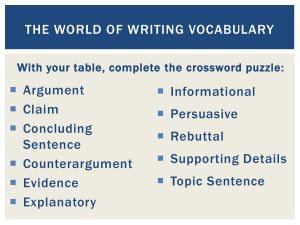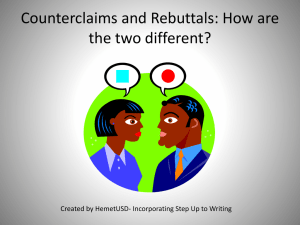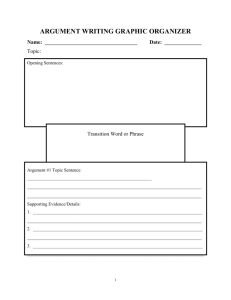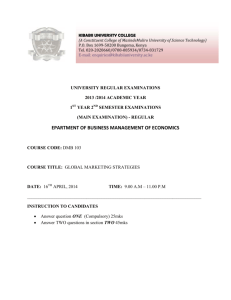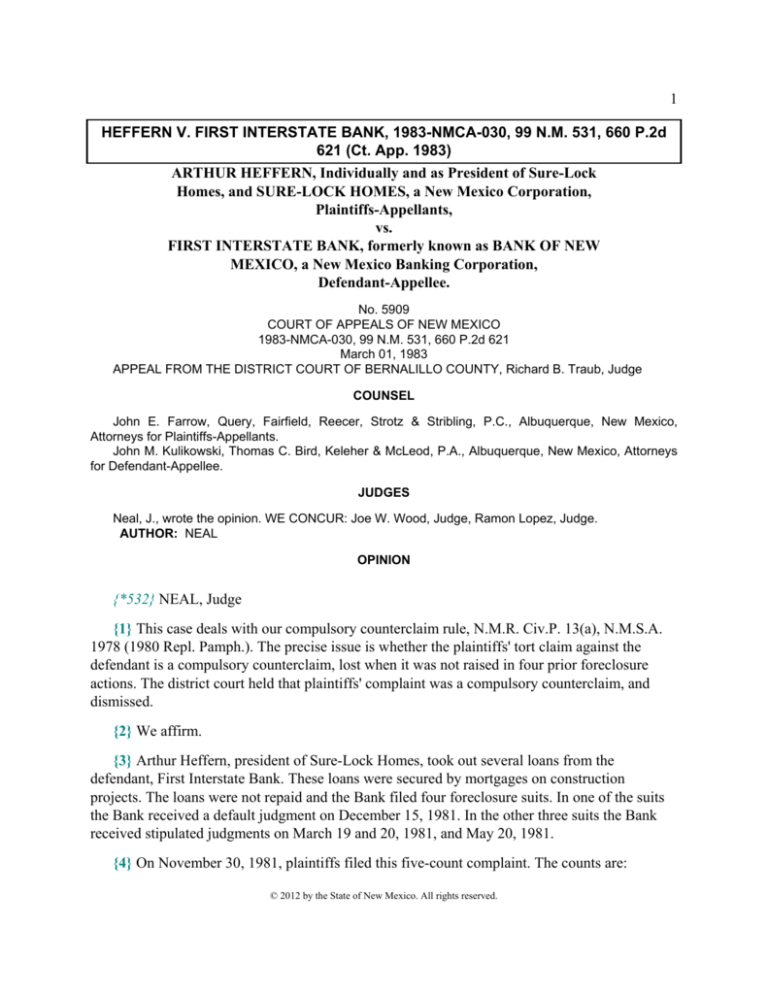
1
HEFFERN V. FIRST INTERSTATE BANK, 1983-NMCA-030, 99 N.M. 531, 660 P.2d
621 (Ct. App. 1983)
ARTHUR HEFFERN, Individually and as President of Sure-Lock
Homes, and SURE-LOCK HOMES, a New Mexico Corporation,
Plaintiffs-Appellants,
vs.
FIRST INTERSTATE BANK, formerly known as BANK OF NEW
MEXICO, a New Mexico Banking Corporation,
Defendant-Appellee.
No. 5909
COURT OF APPEALS OF NEW MEXICO
1983-NMCA-030, 99 N.M. 531, 660 P.2d 621
March 01, 1983
APPEAL FROM THE DISTRICT COURT OF BERNALILLO COUNTY, Richard B. Traub, Judge
COUNSEL
John E. Farrow, Query, Fairfield, Reecer, Strotz & Stribling, P.C., Albuquerque, New Mexico,
Attorneys for Plaintiffs-Appellants.
John M. Kulikowski, Thomas C. Bird, Keleher & McLeod, P.A., Albuquerque, New Mexico, Attorneys
for Defendant-Appellee.
JUDGES
Neal, J., wrote the opinion. WE CONCUR: Joe W. Wood, Judge, Ramon Lopez, Judge.
AUTHOR: NEAL
OPINION
{*532} NEAL, Judge
{1} This case deals with our compulsory counterclaim rule, N.M.R. Civ.P. 13(a), N.M.S.A.
1978 (1980 Repl. Pamph.). The precise issue is whether the plaintiffs' tort claim against the
defendant is a compulsory counterclaim, lost when it was not raised in four prior foreclosure
actions. The district court held that plaintiffs' complaint was a compulsory counterclaim, and
dismissed.
{2} We affirm.
{3} Arthur Heffern, president of Sure-Lock Homes, took out several loans from the
defendant, First Interstate Bank. These loans were secured by mortgages on construction
projects. The loans were not repaid and the Bank filed four foreclosure suits. In one of the suits
the Bank received a default judgment on December 15, 1981. In the other three suits the Bank
received stipulated judgments on March 19 and 20, 1981, and May 20, 1981.
{4} On November 30, 1981, plaintiffs filed this five-count complaint. The counts are:
© 2012 by the State of New Mexico. All rights reserved.
Count I-The Bank, through its agent Carl Rose, extorted money.
Count II-Conversion.
Count III-Wrongful hiring of Rose.
Count IV-Unconscionable trade practices.
Count V-Intentional misconduct; prays for five million dollars in "punitive and exemplary
damages."
{5} On December 28, 1981, the Bank moved to dismiss arguing that under Rule 13 the
complaint was a compulsory counterclaim in the prior foreclosure actions. The trial court granted
the Bank's motion.
{6} Rule 13 states:
(a) Compulsory counterclaims. A pleading shall state as a counterclaim any claim which at
the time of serving the pleading the pleader has against any opposing party, if it arises out of the
transaction or occurrence that is the subject matter of the opposing party's claim and does
not require for its adjudication the presence of third parties of whom the court cannot acquire
jurisdiction. But the pleader need not state the claim if (1) at the time the action was commenced
the claim was the subject of another pending action, or (2) the opposing party brought suit upon
his claim by attachment or other process by which the court {*533} did not acquire jurisdiction
to render a personal judgment on that claim, and the pleader is not stating any counterclaim
under this Rule 13. (Emphasis added.)
{7} We divide our discussion into two parts. First, does Rule 13 apply when no pleading has
been filed? Second, is plaintiffs' complaint a compulsory counterclaim?
1. Rule 13 applies even where no pleading has been filed.
{8} The plaintiffs, pointing out that a default judgment and three stipulated judgments were
entered against them in the four prior foreclosure actions, contend that Rule 13 does not apply
because no pleading was ever filed. They rely on Martino v. McDonald's System, Inc., 598
F.2d 1079 (7th Cir. 1979).
{9} In Martino a contract action against Martino ended in a consent judgment in favor of
McDonald's. In a second action Martino sued McDonald's claiming that the contract provision he
breached, which was the basis of the first action, violated antitrust law. Although Martino stated
that Rule 13 did not apply because no pleading was filed, it held that res judicata barred the
second action. We do not agree with Martino's treatment of Rule 13.
{10} The purpose of the rule is "to prevent multiplicity of actions and to achieve resolution in
a single lawsuit of all disputes arising out of common matters." Southern Const. Co., Inc. v.
Pickard, 371 U.S. 57, 83 S. Ct. 108, 9 L. Ed. 2d 31 (1962). In Ortega, Snead, Dixon & Hanna
v. Gennitti, 93 N.M. 135, 597 P.2d 745 (1979) our Supreme Court, quoting Scott v. United
States, 354 F.2d 292, 173 Ct.Cl. 650 (1965), stated:
The overriding emphasis is on consolidation and the expeditious resolution (where that is
fair) of all the claims between the parties in one proceeding. * * * The controlling philosophy is
that, so far as fairness and convenience permit, the various parties should be allowed and
encouraged to resolve all their pending disputes within the bounds of the one litigation.
{11} Under 13(a) failure to plead a compulsory counterclaim bars a later action on that claim.
Martino, supra; Pipeliners Local Union No. 798, Tulsa, Okl. v. Ellerd, 503 F.2d 1193 (10th
Cir. 1974); Wright and Miller, Federal Practice and Procedure § 1417 (1971). We hold that
Rule 13(a) also applies to the present case.
{12} In holding that, under the circumstances here, Rule 13(a) applies where the prior action
ended in a default judgment, or a stipulated judgment, we find support from other jurisdictions.
The rule has been applied where the first action ended in a default judgment in Technical Air
Products, Inc. v. Sheridan-Gray, Inc., 103 Ariz. 450, 445 P.2d 426 (1968); and Firemen's Ins.
Co. of Newark v. L.P. Steuart & Bro., Inc., 158 A.2d 675 (D.C. Mun. App.1960). As stated in
Technical Air Products:
We would circumvent the purpose of Rule 13(a) if we were to rule that a claim which was
the subject of a compulsory counterclaim is not barred in a subsequent suit merely because
judgment was taken by default rather than on the merits. Such a rule would allow a litigant to
default and then bring a separate action on a claim that would have been compulsory in the first
action had he filed an answer.
{13} Rule 13 has also been applied to stipulated judgments. Harris v. Jones, 404 S.W.2d
349 (Tex. Civ. App.1966); Keller v. Keklikian, 362 Mo. 919, 244 S.W.2d 1001 (1951);
Mensing v. Sturgeon, 250 Iowa 918, 97 N.W.2d 145 (1959); Dindo v. Whitney, 52 F.R.D. 194,
(D.N.H. 1971), aff'd, 451 F.2d 1 (1st Cir. 1971).
{14} In Dindo the plaintiff claimed that Rule 13 did not bar his suit against Whitney because
a prior action ended in a settlement. This argument was rejected:
To hold that Rule 13(a) does not apply when the prior action is settled would completely
subvert the Rule's purpose of bringing about a just and speedy resolution of all the claims
between the parties arising out of the same transaction or occurrence.
52 F.R.D. at 199.
{15} We hold that Rule 13 applies to this case even though no pleading was filed. Any
{*534} other rule would frustrate the purpose behind Rule 13.
2. Plaintiff's complaint is a compulsory counterclaim.
{16} Does the plaintiffs' claim "arise out of the transaction or occurrence that is the subject
matter of the opposing party's claim?" We hold that it does.
{17} In Moore v. N.Y. Cotton Exchange, 270 U.S. 593, 46 S. Ct. 367, 70 L. Ed. 750 (1926),
the Supreme Court, dealing with compulsory counterclaims, stated:
"Transaction" is a word of flexible meaning. It may comprehend a series of many
occurrences, depending not so much upon the immediateness of their connection as upon their
logical relationship.
Although Moore deals with Equity Rule 30, the predecessor of Rule 13(a), it is on point
because 13(a) is broader in scope than old Equity Rule 30. 3 Moore, Federal Practice para. 13.13
at 298-299 (1982). Moore further stated that the claim and the counterclaim need not be
precisely identical.
{18} Federal courts dealing with Rule 13 have adopted the "logical relationship" test to
determine compulsoriness. Pipeliners Local Union No. 798, Tulsa, Okl. supra; Plant v.
Blazer Financial Services, Inc. of Ga., 598 F.2d 1357 (5th Cir. 1979); 1A Barron & Holtzoff
Federal Practice and Procedure § 394 (Wright ed. 1960). Our rule is similar to Federal Rule 13,
and we adopt the "logical relationship" test.
{19} Is there a logical relationship between the plaintiffs' claim and the foreclosure actions
brought by the Bank? Yes. Both have a common origin and subject matter - the loans. This is the
one circumstance without which neither party would have found it necessary to seek relief.
Moore, supra. Both concern operative facts which occurred in roughly the same time span. The
Bank's foreclosure suits arose out of Heffern's failure to make payments due on notes executed
between May 4, 1979 and July 23, 1980, and payable in 1980. The conduct plaintiffs complain
of occurred between August 9, 1979 and July 7, 1980, a period which falls roughly within the
time the notes were due. Also, in Count I plaintiffs allege:
As a direct and proximate result of the malicious and intentional actions of Defendant Bank
as described above, Plaintiff Sure-Lock was unable to meet its financial obligations and was
forced to cease doing business, and as a consequence lost property exceeding $800,000.00 in
value through foreclosure.
The common subject matter of the claim and the counterclaim, the proximity in time between
the operative facts giving rise to each, and the cause and effect relationship between the claim
and the counterclaim all support our conclusion that a "logical relationship" exists between the
plaintiffs' claim and the prior foreclosure suits.
{20} In holding that, under the circumstances of this case, a tort claim is a compulsory
counterclaim to a foreclosure action, we find support from other jurisdictions. Allegations of
creditor misconduct have been held to be compulsory counterclaims in foreclosure suits in
Torbit v. Griffith, 37 Colo. App. 460, 550 P.2d 350 (1976); and Friedrichsen v. Cobb, 84
Mont. 238, 275 P. 267 (1929). In each of these cases the failure to raise the compulsory
counterclaim in the first action barred the second action based on creditor misconduct.
{21} The district court's order of dismissal is affirmed.
{22} IT IS SO ORDERED.
WE CONCUR: Joe W. Wood, Judge, Ramon Lopez, Judge.
——————————

